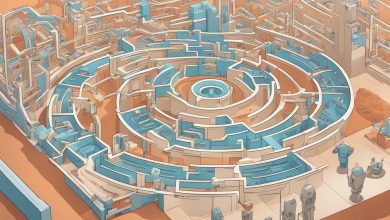
Welcome to the world of smart homes, where modern living meets cutting-edge technology. The concept of a smart home has always been a dream for many homeowners, and today it has become a reality. Thanks to the Internet of Things (IoT), our homes are transforming into intelligent living spaces that can be controlled and customized with just a few clicks. Home automation has made it possible for homeowners to enjoy a seamless living experience, where everything from lighting to temperature is adjusted with precision.
The convergence of IoT and modern living has given rise to smart homes, which are equipped with connected devices and systems designed to make our lives easier and more comfortable. As we continue to integrate smart technology into our daily routines, the possibilities for customization and personalization are endless. In this article, we will explore the world of smart homes and how they are changing the way we live and interact with our living spaces.
The Role of Connected Devices in Smart Homes
The key to a smart home is the integration of connected devices that work together to create a seamless living experience. Smart technology has revolutionized the way we interact with our homes, from controlling the thermostat with a smartphone to turning off lights with a voice command.
The Types of Connected Devices
There are a variety of smart home devices available that cater to different needs and preferences. Some popular connected devices include:
| Device | Function |
|---|---|
| Smart thermostats | Regulate heating and cooling based on preferences and usage patterns |
| Voice assistants | Respond to voice commands to control connected devices and perform tasks |
| Smart lighting | Control lighting through an app or voice command, and adjust brightness and color |
| Smart locks | Control access to a home through an app or biometric recognition, and monitor activity |
| Smart security systems | Monitor and alert homeowners to potential security threats through cameras and sensors |
How Connected Devices Work Together
Connected devices communicate with each other through a central hub, which is often controlled through a smartphone app. This allows homeowners to manage and monitor their devices from anywhere, at any time. For example, a smart thermostat can learn from a smart lighting system’s usage patterns to adjust the temperature in a room based on the level of natural light.
Many devices are also compatible with voice assistants, such as Amazon’s Alexa and Google Assistant, allowing for hands-free control of connected devices. This creates a truly integrated and convenient living experience.
Overall, the role of connected devices in smart homes is to enhance and simplify the way we live. By automating tasks and providing personalized control, homeowners can enjoy a more comfortable and stress-free living environment.
Enhancing Home Security with Smart Technology
In the world of smart homes, home security is a top priority. Smart technology has revolutionized the way homeowners secure their properties, providing a range of convenient, efficient, and effective options. From smart locks to security cameras, connected devices play an essential role in enhancing home security.
One of the most popular connected devices for security is the smart lock. Smart locks allow homeowners to remotely control and monitor their locks through a smartphone app, ensuring that their doors are always secure. Some models even offer advanced features such as voice control and fingerprint recognition.
Another essential smart device for home security is the security camera. Smart cameras offer features such as high definition video, infrared night vision, and motion detection, allowing homeowners to keep an eye on their properties even when they’re not home. Some models can even send alerts to the homeowner’s smartphone when movement is detected, providing instant notification of a potential security breach.
When it comes to home security, smart technology has also enabled homeowners to integrate their various smart devices to create a more cohesive and effective security system. By connecting their smart locks, security cameras, and other devices, homeowners can monitor and control their entire home security system through a single app or hub.
However, it is important to note that security and privacy concerns can arise with the use of smart technology in the home. Homeowners should take steps to protect their devices from hacking or unauthorized access, such as using strong passwords and keeping their firmware up to date.
Overall, smart technology provides homeowners with a range of options for enhancing their home security. By taking advantage of connected devices, homeowners can enjoy the peace of mind that comes with knowing their homes are secure.
Energy Efficiency in Smart Homes
One of the primary benefits of smart homes is their ability to promote energy efficiency through IoT technology. In traditional homes, energy is often wasted due to unnecessary use or overheating of appliances, lighting, and heating/cooling systems. Smart homes, on the other hand, allow homeowners to monitor and control their energy usage in real-time, leading to significant cost savings and reduced environmental impact.
One example of energy-efficient smart technology is smart thermostats. These devices use sensors to detect occupancy and adjust heating/cooling accordingly, ensuring that rooms are only heated or cooled when necessary. They can also be programmed to adjust temperature based on the time of day or outside weather conditions, further reducing energy waste. Additionally, smart lighting systems can be set to turn off automatically when rooms are vacant or dimmed based on natural light levels, saving both energy and money.
Another way in which IoT technology promotes energy efficiency is through smart metering and monitoring. Smart home systems allow homeowners to track their energy usage in real-time, identifying areas of excess consumption and taking corrective action. For example, a smart appliance may notify the homeowner when it has completed a cycle, allowing them to turn it off and save energy. Or, in the case of solar power systems, homeowners can monitor their energy production and usage, optimizing their energy consumption to avoid waste.
Overall, the integration of IoT technology and energy efficiency in smart homes is a win-win for homeowners and the environment. Not only do smart homes lead to cost savings and reduced environmental impact, but they also provide a more convenient and personalized living experience.
The Future of Smart Homes
Smart homes have come a long way since their inception, thanks to the rapid advancement of IoT technology. As we continue to embrace the benefits of home automation, the future of smart homes promises to be even more exciting.
Emerging Technologies and Trends
The integration of AI technology into smart home devices is a major trend to watch out for. With AI, smart homes will be able to learn and adapt to our individual habits and preferences, creating a truly personalized living experience. Voice recognition is also becoming more sophisticated, allowing for hands-free control of various smart devices. Another significant development is predictive analytics, which enables smart homes to anticipate and respond to our needs before we even express them.
Potential Benefits and Challenges
As with any evolving technology, there are potential benefits and challenges associated with the future of smart homes. On the one hand, we can expect to see even more energy efficiency, improved security, and enhanced convenience. On the other hand, home automation may also raise concerns around privacy and security breaches. As smart homes become more widespread, ensuring compatibility across devices may also pose a challenge.
The Future is Smart
Despite the potential challenges, the future of smart homes is undoubtedly bright. As we continue to explore the possibilities of IoT technology, we can look forward to even smarter, more intuitive living spaces. Whether we’re optimizing our energy usage, securing our homes, or simply enjoying the convenience of hands-free control, smart homes are an essential part of modern living.
Overcoming Challenges and Considerations for Smart Home Adoption
As with any new technology, adopting smart home automation comes with its own set of challenges and considerations. Although the potential benefits are significant, homeowners must carefully evaluate whether a smart home setup is right for them. Here are some factors to keep in mind before diving into the world of smart homes.
Cost
Smart home devices can be expensive, and outfitting an entire home with the latest technology can quickly become a budgetary concern. However, it’s important to keep in mind that the cost of smart devices is gradually decreasing, and many homeowners choose to invest in one device at a time, gradually building their smart home infrastructure.
Compatibility
Another challenge that homeowners might face is the compatibility of smart devices. Some devices may require specific operating systems or home automation hubs to work together seamlessly, and not all devices are compatible with each other. It’s important to research and ensure that any devices being considered will work together without issue.
Privacy Concerns
Smart homes generate a vast amount of data that can potentially be accessed by third parties if not secured correctly. Homeowners must take measures to protect their privacy, such as using devices with strong security features, creating complex passwords, and disabling data-sharing options.
Learning Curve
The learning curve associated with operating new technology can be intimidating for some homeowners. While smart devices are generally user-friendly, there may still be a period of adjustment required to become comfortable with using them correctly. Homeowners should consider investing time and effort into researching and familiarizing themselves with the devices they plan to use to ease the transition into a smart home.
By keeping these considerations in mind, homeowners can make informed decisions about whether to embrace smart home technology. With careful planning and due diligence, the benefits of a smart home can far outweigh any challenges or concerns.
Exploring Popular Smart Home Devices and Systems
Smart homes are becoming increasingly popular as homeowners seek to automate and streamline their living spaces. There are a wide range of connected devices and systems available on the market, each with its own unique features and benefits. Here are some popular smart home devices and systems to consider:
Smart Thermostats
Smart thermostats are one of the most popular smart home devices. They allow homeowners to control the temperature of their homes remotely, using a smartphone app or voice commands. Some models also have advanced features like geofencing, which can automatically adjust the temperature based on the user’s location.
| Brand | Model | Features |
|---|---|---|
| Nest | Learning Thermostat | Auto-Schedule, Auto-Away, Energy History, Remote Control |
| Ecobee | SmartThermostat | Voice Control, SmartSensor, Eco+ Savings, Follow Me |
| Honeywell | Lyric T6 Pro | Geofencing, Smart Response, Customizable Color Touchscreen |
Smart Security Systems
Smart security systems are designed to keep homes safe and secure, with features like remote monitoring, motion sensors, and video cameras. They can be controlled via smartphone apps and often integrate with other smart devices in the home.
| Brand | Model | Features |
|---|---|---|
| Ring | Alarm Security Kit | Motion Detector, Door/Window Sensor, Keypad, Contact Sensor |
| ADT | Smart Security | 24/7 Monitoring, Professional Installation, Alexa Integration |
| SimpliSafe | Wireless Home Security | HD Camera, Motion Sensor, Glassbreak Sensor, Panic Button |
Smart Lighting
Smart lighting systems allow homeowners to control the lighting in their homes using a smartphone app or voice commands. They can also be programmed to turn on and off at specific times, and some models even have color-changing capabilities.
| Brand | Model | Features |
|---|---|---|
| Philips Hue | Smart Bulbs | Voice Control, Color Changing, Dimming, Scheduling |
| LIFX | Smart LED Lights | Voice Control, Color Changing, Dimming, Music Sync |
| Nanoleaf | Light Panels | Color Changing, Voice Control, Music Sync, Scene Creation |
These are just a few examples of the many smart home devices and systems available. When choosing devices for your own smart home, it’s important to consider factors such as compatibility, ease of use, and security features. By carefully selecting the right devices, you can create an efficient and convenient smart living space that enhances your quality of life.
Conclusion
In conclusion, smart homes represent a revolutionary development in modern living. Through the convergence of IoT and home automation, homeowners have access to a wide range of connected devices and systems that enhance comfort, convenience, security, and energy efficiency.
As we explored in this article, smart technology has transformed the way we interact with our living spaces, and its potential for future advancements is virtually limitless. However, it is important to acknowledge the challenges and considerations associated with adopting smart home technology.
Despite the potential learning curve associated with smart devices, the benefits are clear. As we continue to rely more heavily on technology in our daily lives, it makes sense to integrate this technology into our homes. By doing so, homeowners can enjoy increased comfort, convenience, security, and energy savings.
We encourage readers to explore the possibilities of creating their own smart living spaces, and to do so with the guidance of trusted experts and resources. By investing in smart home technology, homeowners can enjoy a brighter, more sustainable future.








